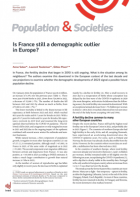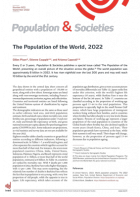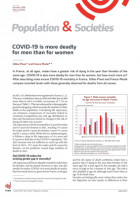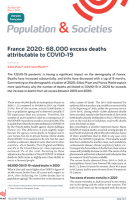
World population: 8 billion today, how many tomorrow?
Population and Societies
n° 604, October 2022
https://doi.org/10.3917/popsoc.604.0001
French Museum of Natural History and French Institute for Demographic Studies.
The world population will reach 8 billion in 2022 and should reach 9 billion by around 2037. The pace of increase is slowing, however. After peaking at 2% 60 years ago, annual growth has fallen by half (1% in 2022) and should continue to decrease until the population levels off at around 10 billion at the end of the century. One of the major demographic features of future decades will be the considerable population growth in Africa, where the population could almost triple by the end of the century, rising from 1.4 billion in 2022 to 3.9 billion in 2100.
world population, demographic transition, population projections, population growth, fertility, mortality, world, Europe, Africa, Asia, Latin America
Table of contents
- Appendix A Reference
1.
The number of people in the world is increasing rapidly, raising concerns about overpopulation. Demographers are projecting that growth will continue for several more decades but at a steadily slower pace. As Gilles Pison explains here, the world population is set to rise by a further 2 billion by the end of the century but will probably level off thereafter.
According to the United Nations, the world population will reach 8 billion in mid-November 2022 [1] (Box 1). From just 1 billion in 1800, it has risen eightfold over the last 2 centuries. This steady increase is likely to continue. Under the UN medium variant projections (Figure 1), the planet will be home to around 10 billion people by the end of the 21st century, while the low and high variants give figures of 7 and 15 billion in 2100. However, according to the UN itself, this range of possibles is extremely broad, with a twofold difference between the high and low variants, and their respective outcomes are highly improbable. Within a narrower range, the UN estimates that there is a 95% chance that the population will be between 8.9 and 12.4 billion in 2100 [1]. Why can we expect this growth to continue? Will it level off over the long term?
1.1. Growth is linked to the demographic transition
Until 2 centuries ago, the population was stable or it increased slowly because birth rates and death rates were almost equal. Severe mortality crises, caused by epidemics and famine, maintained life expectancy at levels of between 20 and 30 years, due mainly to high infant mortality. To compensate for these early deaths, mean fertility was also high, at around 6 children per woman. In the western world, this status quo was disrupted 2 centuries ago. With economic progress, early advances in hygiene and medicine and the emergence of modern government, epidemics and famine were gradually eradicated in Europe and North America. Mortality (especially infant mortality) also fell. But as families were still large, births started to outnumber deaths, and the population began to grow. Across the generations, adults became aware that the proportion of children surviving beyond infancy was increasing. Moreover, the cost of raising large families and sending children to school was becoming a heavy burden. With the spread of the Enlightenment, which advocated individualism and freedom from religious constraints, the notion of voluntary birth control took hold across Europe and North America, and family size decreased. But as mortality was still declining, births continued to outnumber deaths, and the population continued to grow. It was not until later generations that this growth started to slow down, as the number of births decreased to a level matching the increasingly stable number of deaths. This phase marked the end of the transformation in living conditions and behaviours known as the ‘demographic transition’. Under modern conditions of theoretical equilibrium, never actually observed but towards which countries are tending in principle, fertility is close to 2 children per woman and the mean length of life equal to or above 70 years. Births and deaths practically even out.
This process, which has already occurred in the developed countries, is now under way in others. This explains why their populations are now increasing rapidly and fuelling global demographic growth.
1.2. Population growth will continue but at an ever slower pace
The world population is still increasing but ever more slowly (Figure 2). After peaking at 2% 60 years ago, annual growth has fallen by half (1% in 2022) and, under the UN medium variant (Figure 1), should continue to decrease until the world population levels off at around 10 billion at the end of this century.
The acceleration of growth over the last 2 centuries reflects the successive entry of different regions of the world into the demographic transition. The growth peak 60 years ago corresponds to a period when fertility was still high in all Southern countries, at between 5 and 7 children per woman. Mortality in these countries, while still much higher than in the North, had been falling for several years or decades by that time thanks to progress in hygiene and medicine and to socio-economic development. This produced a surplus of births over deaths, which led to steady population growth. The phenomenon had already been identified by demographers, but it was not for some years that the public became aware of the ‘population explosion’. More precisely, it signalled the entry of the Southern countries into the demographic transition at a faster pace than observed in the North several decades or a century earlier. Growth rates of around 3% per year (a doubling of the population in 23 years) were not rare, while in Europe, from 1880 to 1914, countries with long-term annual growth of 1.5% were the exception.
Demographers presumed that the mortality decline in the South would be followed eventually by a fertility decline, as had been the case in the developed world. The spread of voluntary birth control was a slow process in the West; after emerging in the late 18th century in certain countries, well before modern contraception, it did not become universal until the second half of the 20th century. Demographers believed that the South would follow a similar pattern of slow fertility decline, even with the introduction of birth control programmes. They were supported in this belief by ethnologists who described the societies in these regions as strongly family-centred and totally opposed to the idea of limiting births.
1.3. A fast and unexpected fertility decline in Asia and Latin America
Demographers were surprised when surveys revealed the onset of a sharp fertility decline in many countries of Asia and Latin America in the 1960s and 1970s, and population projections for these regions of the world were revised strongly downward. This decline did not produce an immediate slowdown in growth, however, because of demographic inertia: so long as the population is young and has a large proportion of young adults, the number of births remains high even if each couple has few children.
As a result of this new trend, world fertility in 2022 is only 2.3 children per woman on average, less than half the level of 1950 (5 children). But this current global average conceals a wide range of situations. Fertility is lowest in South Korea (0.9 children per woman) and highest in Niger (6.7 children). Two-thirds of the world population now live in countries or regions—including many Southern countries—where fertility is below the replacement level of 2.1 children per woman. This is the case in India (2.0 children per woman), Iran (1.7), Brazil (1.6), Thailand (1.3), and China (1.2).
The world’s regions where fertility is (still) high—above 2.5 children per woman—include practically all of Africa, some countries of the Middle East, and a part of Asia stretching from Kazakhstan to Afghanistan and Pakistan (Figure 3). It is in these regions that population growth will be strongest up to the end of the century, although, as elsewhere across the globe, voluntary birth control should become widespread in years to come.
1.4. Rapid growth in Africa
One of the major demographic features of future decades will be the considerable population growth in Africa. Under the UN medium projection, the continent’s population, including that of North Africa, could almost triple by the end of the century, rising from 1.4 billion inhabitants in 2022 to 3.9 billion in 2100. While 1 person in 6 currently lives in Africa, the proportion will probably be 1 in 4 in 2050 and perhaps above 1 in 3 in 2100. Growth should be especially rapid in sub-Saharan Africa, where, under this same scenario, the population is set to rise from 1.2 billion in 2022 to almost 3.4 billion in 2100.
The demographic transition in Africa will doubtless one day be completed, as on the other continents before it, but the pattern of change will probably be different, for fertility especially. In North Africa, for example, an unexpected fertility rebound has been observed in most countries over recent years. This is probably temporary, and partly attributable to the worsening socio-economic climate and high levels of female unemployment.
In sub-Saharan Africa, the speed of future fertility decline is difficult to predict. While currently slower than in Asia and Latin America several decades ago, the pace of decline is more rapid than that observed in Europe and North America in the past.
Fertility is declining in sub-Saharan Africa, but mainly among the educated and urban populations rather than in rural areas where most of the population still lives. While the fertility decline is still slower than that observed some decades ago in Asia and Latin America (Figure 4), there is no lack of demand for contraception. Although most rural families have yet to adopt a two-child family model, they would prefer to have fewer children and to space them further apart. They are ready to use contraception for this purpose, but the necessary services are not always available. National birth control programmes exist but are ineffective because they lack resources and, above all, because their organizers and the personnel responsible for implementing them are not convinced of their necessity. Many people, including at top government level, see no reason to limit the number of births even if this is not the official line adopted with respect to international organizations. Alongside the relatively low level of development, this is one of the differences from Asia and Latin America in the 1960s and 1970s, and one of the obstacles to faster fertility decline in sub-Saharan Africa.
***
The short-term future of the world population is largely predictable. Demographic projections are quite reliable for forecasting population size over the next 10, 20, or 30 years. Most of the people who will be alive over these next few decades have already been born, the number living today is known, and we can estimate rather accurately the proportion who will die over the period. The number of future births can also be estimated since the women who will bear children over the next 20 years have already been born, their numbers are known, and their potential fertility can be estimated. Beyond the next 30 years, however, the future is more uncertain, with no models upon which to base forecasts. The demographic transition, which has served well to predict changes over the last 2 centuries, will be of little use for this distant future.
While humankind can, as of now, start working towards long-term equilibrium, the most pressing issues concern the short term, i.e. the coming years and decades. It would be unrealistic to imagine that demographic trends can be modified substantially over this period. However, while the population is still increasing, the pace of growth is slowing down naturally, since humans have chosen to have fewer children and to focus on quality and length of life. The world population will inevitably increase by 2 billion over the next 30 years because of demographic inertia that no one can prevent. We nonetheless have the power to change our way of living—and urgently need to do so—by ensuring greater respect for the environment and for biodiversity and more efficient use of natural resources. All in all, the long-term survival of humankind depends less on population size than on how we choose to live.
1.4.1. Box 1. Eight billion on 15 November 2022: can we be sure?
According to the United Nations, the world population will reach precisely 8 billion on 15 November 2022. But how can we be sure? National censuses provide us with information on population numbers for all countries of the world, although their quality varies. They can be used to estimate the total number of human beings to within a few percentage points. The world population may already have topped 8 billion, or will not do so for another couple of years. Global demographic trends are well understood, however, and we already know that the world population will be between 9 billion and 11 billion by 2050.
1.4.1. Box 2. To find out more about world population, visit the INED website at: www.ined.fr/en
The ‘All about population’ pages provide a wide range of information about the world population:
• ‘The world population and me’: find out where you stand in the world population.
• ‘World population in graphs’: view the United Nations population statistics, travel from one country to another, track changes over time, and rank and compare countries.
• ‘Population maps’: see world maps for some 30 demographic indicators and track changes since 1950.
• ‘Population simulator’: choose your own assumptions to simulate future population trends.
The INED website offers a broad range of animations, videos, factsheets, and publications on world population.
Appendix A Reference
-
[1] United Nations, 2022, World population prospects: The 2022 revision, New York, United Nations Department of Economic and Social Affairs, Population Division. https://population.un.org/wpp
Cite the article
Gilles Pison, World population: 8 billion today, how many tomorrow?, 2022, Population and Societies, no. 604
 This document may be reproduced free of charge on paper or online using our Creative Commons licence.
This document may be reproduced free of charge on paper or online using our Creative Commons licence.


























